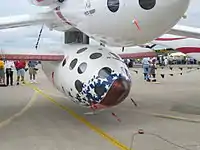Brian Binnie | |
|---|---|
 Binnie in 2004 | |
| Born | April 26, 1953 West Lafayette, Indiana, U.S. |
| Died | September 15, 2022 (aged 69) |
| Resting place | Arlington National Cemetery |
| Nationality | American |
| Alma mater | Brown University Princeton University |
| Occupation | Test pilot |
| Space career | |
| Commercial astronaut | |
| Rank | Commander, United States Navy |
Time in space | ~5 minutes |
| Selection | SpaceShipOne 2003 |
| Missions | SpaceShipOne flight 17P |
William Brian Binnie (April 26, 1953 – September 15, 2022) was a United States Navy officer and one of the test pilots for SpaceShipOne, the experimental spaceplane developed by Scaled Composites and flown from 2003 to 2004.
Early life

Binnie was born in West Lafayette, Indiana, on April 26, 1953,[1] where his Scottish father William P. Binnie was a professor of physics at Purdue University. The family returned to Scotland when Binnie was five, and lived in Aberdeen (his father taught at Aberdeen University) and later in Stirling.[2] When Binnie was a teenager the family moved to Boston.[3]
Binnie earned a bachelor's degree in aerospace engineering from Brown University. He earned a master's degree from Brown in fluid mechanics and thermodynamics. Binnie was rejected by the United States Air Force, and enrolled at Princeton University, where he earned a master's degree in mechanical and aerospace engineering[3] He served for 21 years in the United States Navy as a naval aviator, reaching the rank of commander.[4] He flew the A-7 Corsair II, A-6 Intruder, F/A-18 Hornet, and AV-8B Harrier II. He graduated from the U.S. Naval Test Pilot School in 1988. Binnie also copiloted the Atmospheric Test Vehicle of the Rotary Rocket. In 2006, he received an honorary degree from the University of Aberdeen.[5]
SpaceShipOne and spaceflight

On December 17, 2003, the 100th anniversary of the Wright brothers' first powered flight, Binnie piloted the first powered test flight of SpaceShipOne, flight 11P, which reached a top speed of Mach 1.2 and a height of 12.9 miles (20.7 km). On October 4, 2004, he piloted SpaceShipOne's second Ansari X Prize flight, flight 17P, winning the X Prize and becoming the 436th person to go into space. His flight, which peaked at 367,442 feet (69.6 mi; 112.0 km), set a winged aircraft altitude record for suborbital flights,[6] breaking the old record set by the North American X-15 in 1963.[7] It also earned him the second Astronaut Badge to be given by the FAA for a flight aboard a privately operated commercial spacecraft.[8]
Later career
In 2014 Binnie joined XCOR Aerospace as senior engineer and test pilot, after working as a test pilot and program business manager for Scaled Composites for many years.[9]
Personal life
Binnie and his wife, Bub, had three children.[4][10]
Binnie died on September 15, 2022, at age 69.[1]
References
- 1 2 "Brian Binnie, SpaceShipOne test pilot who won XPRIZE, dies at 69". collectSPACE. September 19, 2022. Retrieved September 19, 2022.
- ↑ "Stirling has a space ace". Stirling Observer. July 19, 2006. Retrieved November 4, 2006.
- 1 2 Kiely, Kathy (February 23, 2005). "Rocket man | Brian Binnie*78's pioneering flight could help open doors to civilian space travel". Princeton Alumni Weekly. Retrieved November 4, 2006.
- 1 2 Philippa Kennedy (October 26, 2008). "To infinity and beyond: the tourist generation". Thenationalnews.com. Retrieved September 20, 2022.
- ↑ "Degree for 'first Scot in space'". BBC News. July 3, 2006. Retrieved November 4, 2006.
- ↑ "FAI Record ID #9881 – Altitude above the earth's surface with or without maneuvres of the aerospacecraft, Class P-1 (Suborbital missions) Archived October 18, 2015, at the Wayback Machine" Mass Archived September 24, 2015, at the Wayback Machine Time Archived September 24, 2015, at the Wayback Machine Fédération Aéronautique Internationale (FAI). Retrieved: September 21, 2014.
- ↑ Brekke, Dan (October 4, 2004). "SpaceShipOne Wins the X Prize". Wired. Retrieved November 4, 2006.
- ↑ "FAA Commercial Human Spaceflight Recognition". web.archive.org: Federal Aviation Administration. June 9, 2022. Archived from the original on July 12, 2022. Retrieved September 21, 2022.
- ↑ Klotz, Irene (April 3, 2014). "Spaceship Pilot Joins Rival Firm". Space News. Archived from the original on April 3, 2014. Retrieved April 4, 2014.
- ↑ Drysdale, Neil (September 19, 2022). "Brian Binnie, who grew up in Aberdeen and followed Neil Armstrong into space, dies age 69". The Press and Journal. Retrieved September 20, 2022.
